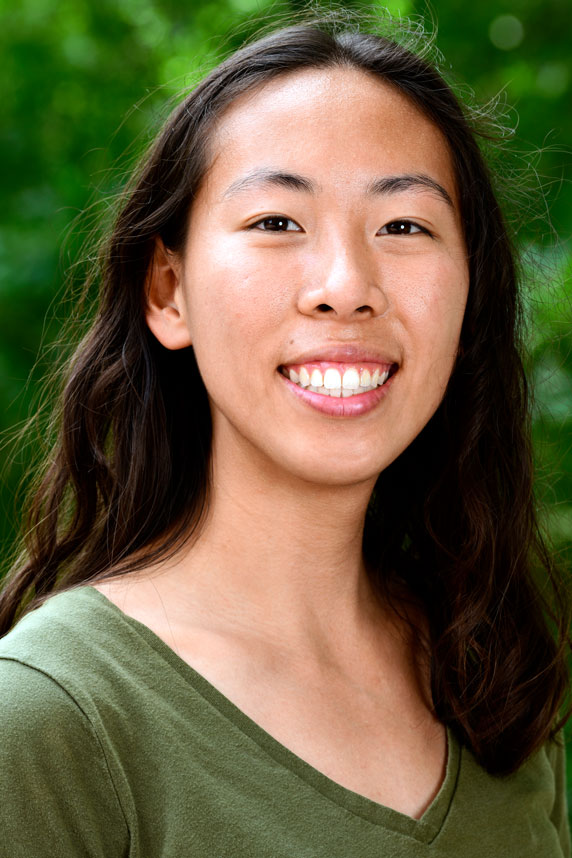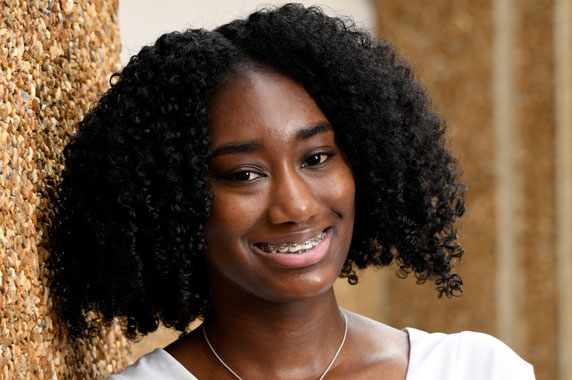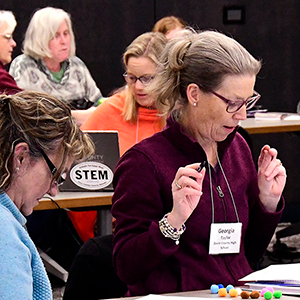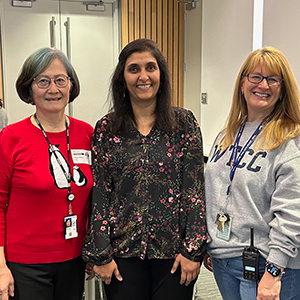The annual NIEHS Scholars Connect Program (NSCP) spring symposium, held April 15, featured an impressive and resilient cohort of undergraduate students. Ten aspiring scientists and their NIEHS mentors presented the research projects completed during a remote internship that began last summer.
The event was hosted by Ericka Reid, Ph.D., director of the NIEHS Office of Science Education and Diversity (OSED) and NSCP director, and Suchandra Bhattacharjee, Ph.D., OSED undergraduate research training program manager and NSCP coordinator. Trevor Archer, Ph.D., NIEHS deputy director, served as session chair of the event.
 Wu researches why people choose to be physically active. (Photo courtesy of Steve McCaw / NIEHS)
Wu researches why people choose to be physically active. (Photo courtesy of Steve McCaw / NIEHS)Each year, students serve three semesters in an NIEHS internship that includes full-time work in the summer and part-time work during the fall and spring semesters. The scholars earn a stipend while working with NIEHS scientists on a full research project, where they define their project, develop research questions, conduct experiments, analyze data, and present their findings. The scholars present their work three times over the course of the year, with the spring symposium being the culmination and final presentation of the year’s work, Reid said.
Outstanding scholars
The NSCP 2021-2022 Outstanding Scholar Award was granted to Jessica Wu, a junior biomedical engineering major at the University of North Carolina at Chapel Hill (UNC). Her research explored exercise-induced dopamine levels in mice during wheel running activities. Wu’s research mentors are Ayland Letsinger, Ph.D., and Jerry Yakel, Ph.D.
Honorable mention for the Outstanding Scholar Award went to Micah Hysong, a senior biochemistry and genetics major at North Carolina State University (NCSU). Hysong’s presentation highlighted the differences in cell signaling of genetically identical cells in response to environmental exposures. Hysong’s research mentor is Joseph Rodriguez, Ph.D.
Reproductive health
Best Presenter Award was earned by J’ya Hunter, a senior biology major at North Carolina A&T State University. Hunter presented research investigating the long-term effects of environmental exposures on human endometrial cells. Hunter was also designated the 2021-2022 NIEHS/Society of Toxicology (SOT) Undergraduate Scholar, a partnership among the two organizations established in 2019. Hunter is a mentored by Linda Yu, M.D., and Darlene Dixon, D.V.M., Ph.D.
 Hunter, left, was named an Undergraduate Diversity Travel Award Recipient by SOT. Hysong, right, was awarded best presenter at the Fall Connection and received honorable mention at the Spring Connection. (Photos courtesy of Steve McCaw / NIEHS)
Hunter, left, was named an Undergraduate Diversity Travel Award Recipient by SOT. Hysong, right, was awarded best presenter at the Fall Connection and received honorable mention at the Spring Connection. (Photos courtesy of Steve McCaw / NIEHS)Hysong and Wu each received honorable mention for Best Presenter Award.
Jadesola Oladosu, a senior pharmacology major at North Carolina Central University mentored by Sue Fenton, Ph.D., presented work on categorizing environmental mixtures by breast cancer risk that recently received the Society of Toxicology Undergraduate Research Award.
Other reproductive health research was presented by Bhairavy Puviindran, a senior biomedical engineering major at NCSU. She who worked with the Male Reproduction and RNA Biology Group on a project exploring spermatogenesis.
Maya Logan, a senior at UNC majoring in bioinformatics and public policy, worked with the Pregnancy and Female Reproduction Group. She investigated endometrial cells using an organoid model — a 3D in vitro tissue construct mimicking the uterine endometrium.
 Reid and Bhattacharjee are preparing to welcome the incoming 2022-2023 NSCP cohort in June. To learn more about NSCP, read this December 2020 Environmental Factor article. (Photos courtesy of Steve McCaw / NIEHS)
Reid and Bhattacharjee are preparing to welcome the incoming 2022-2023 NSCP cohort in June. To learn more about NSCP, read this December 2020 Environmental Factor article. (Photos courtesy of Steve McCaw / NIEHS)From genetics to diversity
Other presentation topics included gene by environment interactions and diversity, equity, inclusion, and accessibility in science.
- Rajee Ganesan, a senior quantitative biology major at UNC mentored by Jason Watts, M.D., Ph.D., explained that the shape and structure of RNA may play a role in regulating responses to environmental stress.
- Violet Evans, a junior biostatistics major at UNC, investigated methods applied to genetic predisposition of disease development by environmental exposures using data from the UK Biobank. Evans is mentored by John House, Ph.D., and Alison Motsinger-Reif, Ph.D.
- Ariana Frazier, a junior public health major at NCSU, examined recruitment efforts among minority-serving higher education institutions. Frazier is mentored by Joan Packenham, Ph.D.
- Ameena Hester, a junior environmental science major at UNC, examined racial disparities identified in the NIEHS Agricultural Health Study, such as the mortality odds of Black versus white farmers after adjusting for education, health, and other variables. Hester’s mentors are Christine Parks, Ph.D., and Dale Sandler, Ph.D.
Reid developed NSCP to offer nearby undergraduate students from underrepresented groups an opportunity to collaborate with NIEHS scientists while enhancing relationships among NIEHS and area colleges and universities. The program launched in 2012.
A full list of the NSCP Scholars is available here.
(Jennifer Harker, Ph.D., is a technical writer-editor in the NIEHS Office of Communications and Public Liaison.)










